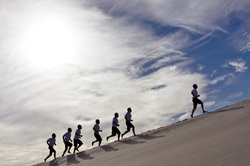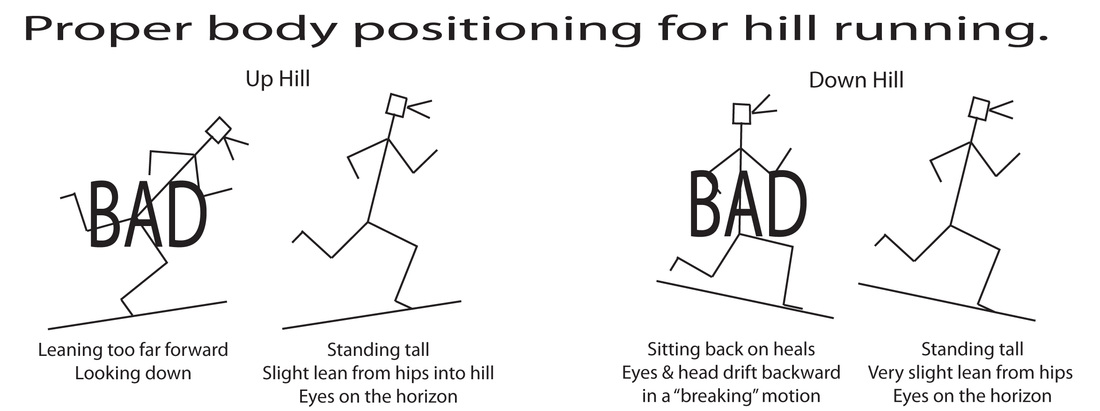How to run hills like a hero!

HEAD: Keep your head and chest up. Don't slouch. Attempting to "grit out" a hill, many runners put their head down, which wastes energy by throwing off their form.
EYES: To keep your body upright, fix your eyes directly ahead of you, not down at your feet. You will sleekly move up the hill.
HANDS: Keep your hands loose, no fists. Loose hands help your whole body stay relaxed.
LEGS: Keep knee lift to a minimum. Take little steps, like one step vs. two on a staircase.
GOING UP: Run the first two-thirds of the hill relaxed, then slightly accelerate the last part, while carrying your pace over the top. Don't push too hard at the bottom of a hill. Then you're dead at the top.
BRAIN: Visualize the crest of a hill 20 meters beyond where it really is, so you run to the top-and keep going. Tell yourself, 'Up and over, up and over,' and don't relax till past the top."
TORSO: Lean forward a bit. It maintains momentum. But don't bend excessively.
ARMS: Coach and marathon champ Alberto Salazar emphasizes accelerated arm action to drive up a hill: "Concentrate on overusing the arms to really power up, so your running almost simulates sprinting." Your arms should form a 90-degree angle at the elbow, and swing straight back and forth, not across your body.
FEET: Get up on your forefeet and take shorter strides. Run with punctuation.
GOING DOWN: Your feet should land underneath you. This produces minimal shock on the body. A shortened arm swing will help shorten the stride.
WHY BOTHER?: Strength, efficiency, endurance. A study published in the Journal of Biomechanics found running on a steep grade at a fast pace achieved greater "muscle activation" in the legs and hip area than running at a slow pace.
SHORT ON TIME: Short hills provide maximum training effect with minimum injury risk. Start with three or four repetitions up a hill about 60 to 80 meters long at top speed. Recover fully between runs.
DISTANT MEMORIES: Longer hills teach the body to recruit muscle fibers when they're fatigued. This helps you develop a kick. Start with three or four reps of a hill 300 to 600 meters long. Recover fully between runs.
LAUGH AT PAIN! When you start to hurt, smile! Be happy that you are healthy and active and able to run hills.
EYES: To keep your body upright, fix your eyes directly ahead of you, not down at your feet. You will sleekly move up the hill.
HANDS: Keep your hands loose, no fists. Loose hands help your whole body stay relaxed.
LEGS: Keep knee lift to a minimum. Take little steps, like one step vs. two on a staircase.
GOING UP: Run the first two-thirds of the hill relaxed, then slightly accelerate the last part, while carrying your pace over the top. Don't push too hard at the bottom of a hill. Then you're dead at the top.
BRAIN: Visualize the crest of a hill 20 meters beyond where it really is, so you run to the top-and keep going. Tell yourself, 'Up and over, up and over,' and don't relax till past the top."
TORSO: Lean forward a bit. It maintains momentum. But don't bend excessively.
ARMS: Coach and marathon champ Alberto Salazar emphasizes accelerated arm action to drive up a hill: "Concentrate on overusing the arms to really power up, so your running almost simulates sprinting." Your arms should form a 90-degree angle at the elbow, and swing straight back and forth, not across your body.
FEET: Get up on your forefeet and take shorter strides. Run with punctuation.
GOING DOWN: Your feet should land underneath you. This produces minimal shock on the body. A shortened arm swing will help shorten the stride.
WHY BOTHER?: Strength, efficiency, endurance. A study published in the Journal of Biomechanics found running on a steep grade at a fast pace achieved greater "muscle activation" in the legs and hip area than running at a slow pace.
SHORT ON TIME: Short hills provide maximum training effect with minimum injury risk. Start with three or four repetitions up a hill about 60 to 80 meters long at top speed. Recover fully between runs.
DISTANT MEMORIES: Longer hills teach the body to recruit muscle fibers when they're fatigued. This helps you develop a kick. Start with three or four reps of a hill 300 to 600 meters long. Recover fully between runs.
LAUGH AT PAIN! When you start to hurt, smile! Be happy that you are healthy and active and able to run hills.
